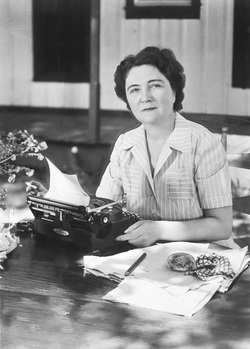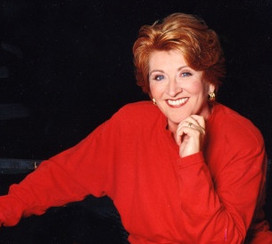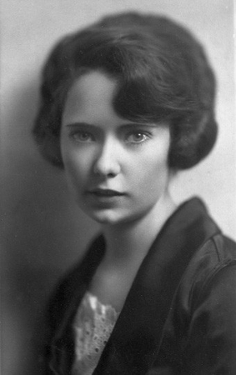 A native Washingtonian, Marjorie Kinnan was born on August 8, 1896 in the Brookland neighborhood of Washington, D.C., single child to Arthur Frank Kinnan, an attorney with the U.S. Patent & Trademark Office, and Ida May Traphagen Kinnan. Marjorie has claimed that she inherited her love of nature from her father, with whom she was very close. Nurturing a rapport for rich, natural settings in favor over more urban environments and cities, Marjorie spent her childhood summers visiting her mother’s family farm in Southern Michigan. Her affinity for nature surfaced prominently throughout her writing very early on - as early as the age of six, Marjorie began publishing letters and short stories in the children’s section of various local newspapers until her teenaged years. At 15 years old, she won a prize for her story titled, “The Reincarnation of Miss Hetty.” A few years later, upon her father’s passing, Marjorie and her mother moved to Wisconsin, where Marjorie attended the University of Wisconsin-Madison. She pursued drama and writing, thriving at her studies, eventually earning a degree in English with honors. While working for her university’s Wisconsin Literary Magazine, she met and fell in love with Charles Rawlings, whom she later married in 1919. The newlyweds moved briefly to Charles’ hometown of Rochester, New York, before moving to Louisville, Kentucky, both in search of more meaningful writing jobs they could enjoy. Following short stings as a feature writer for the Louisville Courier-Journal and a columnist for “Live Women in Louisville,” Marjorie moved back to Rochester to begin writing for the Rochester Evening Journal and to focus on other personal writings, including a poetry series and a novel. Both Marjorie and Charles often felt restless with their lives and careers. Upon receiving a small inheritance from her mother’s passing, Marjorie decided to purchase a farm in Florida, close to a small rural community called Cross Creek. The move reignited her passion for nature, and she felt deeply connected with the wilderness of the surrounding lands as much as she was fascinated by the lives of its inhabitants - both human and non-human. Marjorie began recording detailed descriptions of various plants and animals, as well as observations regarding the local residents’ lives, Southern dialect and food recipes. She would later use these writings as fodder for her published works. Her first novel, South Moon Under, about her experiences with moonshining was published in 1933, and was selected as a finalist for the Pulitzer Prize. Marjorie later wrote Cross Creek, an autobiographical account of her life and those of her neighbors in Florida, and then finally Cross Creek Cookery, a compilation of Southern recipes she was most fond of and passionate about. Her most popular work, however, was The Yearling, a coming-of-age fiction novel chronicling a young farmer boy’s life growing up with his adopted pet fawn. Published in 1938, the work instantly became a best-seller, earning Marjorie a Pulitzer Prize the very next year. While her book was written long before the concept of young-adult fiction existed, the novel experienced such success that it was later turned into a film adaptation, and is still included in academic reading lists today. In Marjorie’s later years, she taught creative writing at the University of Florida in Gainesville. She left the school most of her property upon her death by a ruptured aneurysm, in 1953. Many say her reputation and writings have outlived her contemporary peers. Her children’s book, The Secret River, was published post-humously in 1956 and earned a Newbery Honor Award. In 2008, the United States Postal Office unveiled a stamp in her honor. By Kim Tran  Yoon Joung Lee American actress, comedienne and author, Fannie Flagg, was born Patricia Neal in Birmingham Alabama in 1944 as the daughter of Marion Leona and William Hurbert Neal, Jr. Her father and grandfather were both projectionists and therefore, she grew up around movies and learned how to operate spotlights. At the age of eight, she began her acting career by writing and staging a play called “The Whoopee Girls.” With her next work “Town and Gown Theatre” she started as a spotlight operator, then as an actress when she was fifteen. When she was eighteen, she debuted on stage for “On the Town” as an old lady and adopted her stage name “Fannie Flagg” to distinguish herself from a well-known Oscar-winning actress named Patricia Neal. After graduating from Ramsay High School, she became a co-host for “Morning Show” at WBRC 6 with Joe Langston and Tom York in the 1960s. In 1964, she was hired as a staff writer for Allen Funt’s Candid Camera and begun to appear on various game shows such as the Match Game and Password with her Southern charm and wit. In 1970, she made her screen debut as an actress in “Five Easy Pieces.” Later, she also played small roles in “Rabbit Test,” “Grease,” and the TV show “Wonder Woman.” In addition to television and film, she also acted on Broadway shows- “Come Back to the Five and Dime,” “Jimmy Dean,” and “The Best Little Whorehouse in Texas.” During the 1960s and 1970s, she recorded two comedy albums including many parodies of “Lady Bird Johnson” and “Martha Mitchell.” She also wrote comedy routines and submitted articles to magazines and newspapers including the New York Times Book Reviews. Then in the 1980s, she focused seriously on novel writing. Her first novel, Coming Attractions: A Wonderful Novel, was published in 1981 and reissued as Daisy Fay and the Miracle Man in 1992. Flag's most well known novel Fried Green Tomatoes at the Whistle Stop Café was adapted into the 1991 movie Fried Green Tomatoes. She was nominated for an Academy Award for the screenplay adaptation. Flagg has spoken publicly about her struggles with dyslexia causing her difficulty with spelling and her writing career was put on hold for much of the 1970s. However, she overcame fear and finished several novels and screenplays. She now divides her time between homes in Alabama and California.  Yoon Joung Lee The author of Gone With the Wind, one of the most popular books of all time, Margaret Mitchell, was born in Atlanta, Georgia in 1900. Her father was a historian and lawyer, and her mother was a suffragist. Since her young age, she loved to hear other’s stories and write in her own way. As a child, she was fascinated by the Civil War stories she heard from Confederate veterans. She also wrote, produced, and directed plays. She cast her friends and performed her stories on the porch in front of her neighbors. In 1918, she entered Smith College, but soon she had to drop out the school to take her place as mistress of the household after her fiance, Clifford Henry, died in action in World War I and her mother died during a flu epidemic, the following January. In 1922, she married Berrien “Red’ Upshaw who was an ex-football player from a prominent Raleigh, North Carolina, family. During their short period of marriage, she began writing for the Atlanta Journal Sunday Magazine while under financial pressures. However, their marriage didn’t last long. Upshaw left Atlanta for the Midwest four months after the wedding and he never came back. Within a year she married John Marsh who was a former suitor and an editor at the paper. There, she wrote 129 articles while working as an advice columnist and a proofreader. After four years at the paper, she had to leave the job due to a series of injuries including a broken ankle. During this time, she wrote the book which made her famous. In 1936, her book Gone With the Wind was published and Mitchell was awarded the Pulitzer Prize. This book made her a celebrity overnight and she remained very much in the public spotlight. In 1939, the book was made into an equally famous motion picture, starring Vivien Leigh and Clark Gable and the film’s world premiere was held at the Loew’s Grand Theater in Atlanta. Gone With the Wind was Mitchell’s only published novel. Since international copyright laws were different from country to country and those were ambiguous, she spent so much time working to protect the copyright of her book abroad. She also spent much of her time answering every letter she received about her book. During the World War II outbreak, she worked for the American Red Cross. In 1949, Mitchell and her husband crossed the street to go to a movie theater. Mitchell was hit by a speeding taxi cab driven by a drunken driver. She was rushed to Grady hospital but never regained consciousness. She died at the hospital five days after the accident and was buried in Atlanta’s Oakland Cemetery in 1949. She was listed in Georgia Women of Achievement in 1994 and the Georgia Writers Hall of fame in 2000. |
Archives
July 2017
Categories
All
|
 RSS Feed
RSS Feed